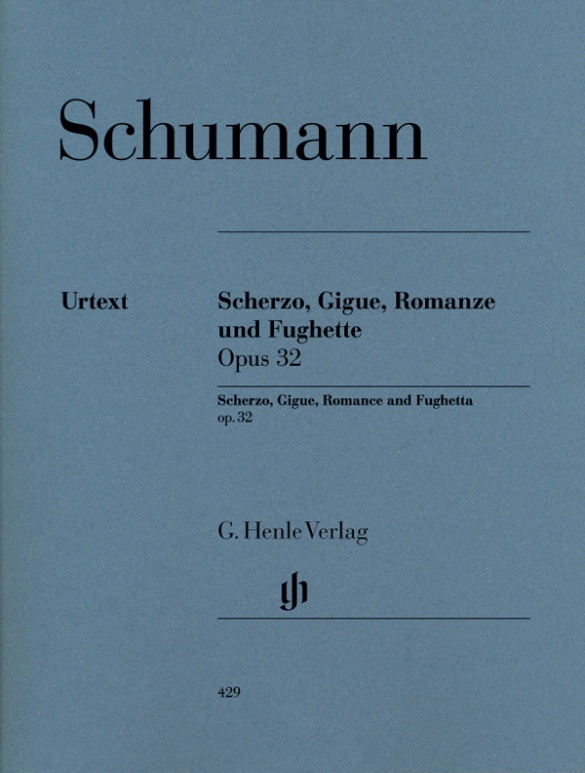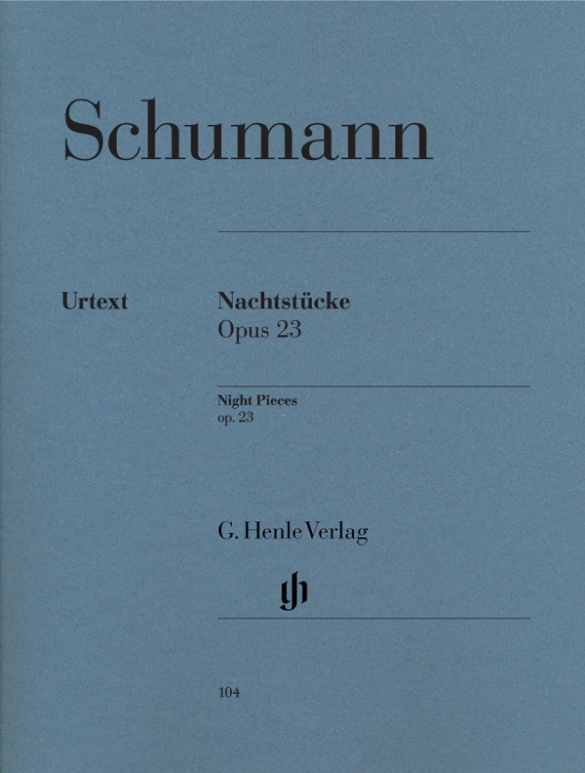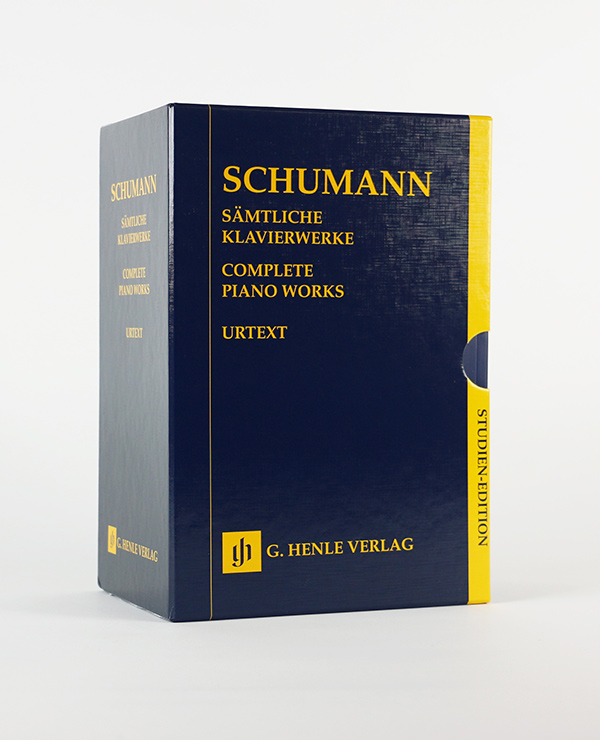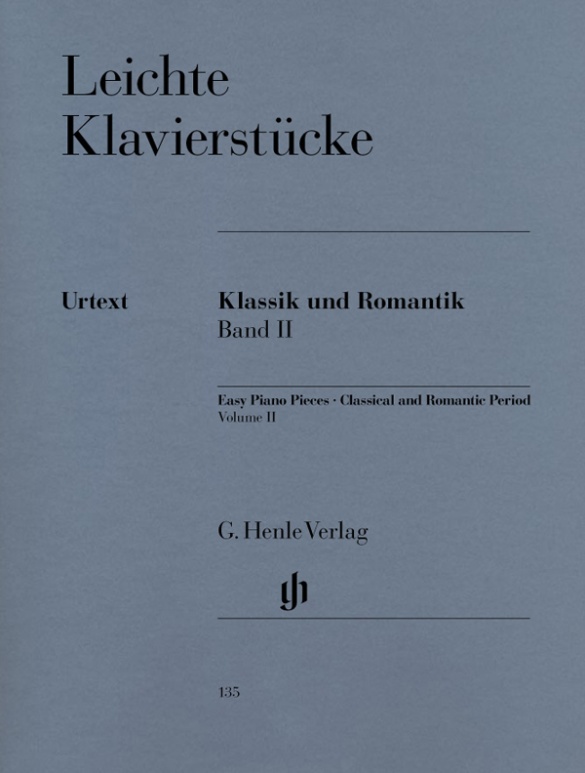Robert Schumann
Scherzo, Gigue, Romance and Fughetta op. 32
The Henle catalogue contains almost all of Schumann’s works for piano in top quality editions. With the publication of op. 32 we are filling an important gap. In or-der to help his “Neue Zeitschrift für Musik” to become more successful, Schumann gave it a practical use: he enclosed the music for short works. The Bach-like “Gigue” and “Fughetta” also appeared here. The “Scherzo” and “Romance” are on the other hand Romantic forms. It was only later that he put the pieces in their current sequence. The renowned Schumann pianist Leif Ove Andsnes kindly allowed us to use his fingerings in our edition. It is a compelling alternative to the frequently used albums in teaching. And a real discovery for pianists who want to play Schumann’s magnificent music.
Content/Details
(Explanation)
About the Composer
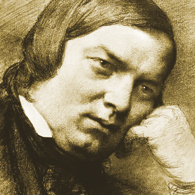
Robert Schumann
Connected with his oeuvre is the term he coined, Poetic Music, with which he strove for a fusion of literature and music, a paradigm particularly seen in his lyric piano pieces prior to 1839. Thereafter he devoted himself to other genres (song, symphony, chamber music, among others).
| 1810 | Born in Zwickau on June 8, the son of a bookdealer. |
| from 1828 | Studies law in Leipzig, piano with Friedrich Wieck. Decision to pursue a career in music. |
| 1830–39 | He exclusively composes piano works, mostly cycles, including “Papillons,” Op. 2 (1829–32); “Carnaval,” Op 9 (1834/35); “Davidsbündlertänze,” Op. 6 (1837); “Kinderszenen” (“Scenes from Childhood”), Op. 15 (1837/38); “Kreisleriana,” Op. 16 (1838); “Noveletten,” Op. 21 (1838). |
| 1832 | A paralysis of a finger in his right hand makes a career as a pianist impossible. Founding in 1833 of the fantasy brotherhood the “Davidsbund” (“League of David”). |
| 1835–44 | Editor of the Neue Zeitschrift für Musik (New Journal of Music). |
| 1840 | Marriage to Clara Wieck; 138 songs, including the Eichendorff Liederkreis, Op. 39; the song cycle “Dichterliebe,” Op. 48 |
| 1841 | Symphony No. 1 in B-flat major (“Spring” Symphony), Op. 38, and Symphony No. 4 in D minor, Op. 120. |
| 1842 | Three string quartets, Op. 41; further chamber music. |
| 1843 | Teacher of composition at the Leipzig Conservatory. Oratorio “Paradise and the Peri,” Op. 50. |
| 1845 | He settles in Dresden. Journey to Russia. |
| 1845 | Piano Concerto in A minor, Op. 54, Symphony No. 2 in C major, Op. 61. |
| 1850 | City music director in Düsseldorf. Premiere in Leipzig of his opera “Genoveva,” Op. 81. Symphony in E-flat major (“Rhenish”), Op. 97; Cello Concerto in A minor, Op. 129. |
| 1853 | Beginning of his friendship with Brahms. Completion of the Scenes from Faust. Violin Concerto in D minor for Joseph Joachim. |
| 1854 | Suicide attempt and admission to the psychiatric institution in Endenich, near Bonn. |
| 1856 | Death in Endenich on July 29. |
About the Authors

Wiltrud Haug-Freienstein (Editor)
Dr. Wiltrud Haug-Freienstein, born in 1955 in Riedlingen, read musicology at the Ludwig-Maximilians-Universität in Munich and was awarded her doctorate in 1987 for her thesis entitled “Motiv, Thema und Kompositionsaufbau bei Franz Liszt”.
She started out as a freelance editor for G. Henle Publishers, where she became a permanent editor in 1987, following a three-year period at the Richard Wagner Complete Edition in Munich. She remained at G. Henle Publishers until 2008. She edited and supervised the publication of numerous Urtext editions.
Leif Ove Andsnes (Fingering)
Product Safety Informations (GPSR)

G. Henle Verlag
Here you can find the information about the manufacturer of the product.G. Henle Verlag e.K.
Forstenrieder Allee 122
81476 München
Germany
info@henle.de
www.henle.com
Die gut zu gebrauchende Henle Ausgabe benützt Schumanns Handexemplar als Hauptquelle. Sie ergänzt alle fehlenden, musikalisch notwendigen Vortragszeichen. Es lohnt sich, die nicht allzu schweren Werke zu spielen, obwohl sie ursprünglich sicherlich nicht als Konzertstücke gedacht waren …
NMZ, 2007Mit der vorliegenden Veröffentlichung schließt der Henle-Verlag eine nicht unbedeutende Lücke in seinem eigenen Verlagsprogramm und stellt zugleich der Kempff-Ausgabe eine moderne Urtextedition gegenüber, für die Leif Ove Andsnes seine Fingersätze beisteuerte.
Piano News, 2006Fingered by Leif Ove Andsnes the work is tender and the score delightfully clean.
Piano professional, 2006Une alternative attrayante aux pièces régulièrement jouées dans les classes de piano.
Crescendo, 2006recommendations
autogenerated_cross_selling
Further editions of this title
Further editions of this title


